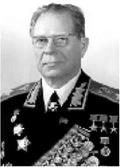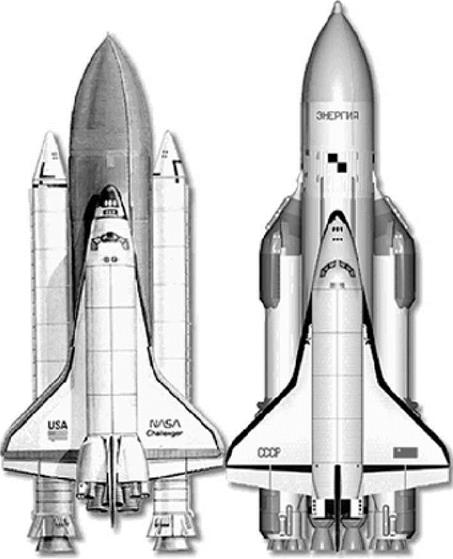Known as Raskat (“peal of thunder”) or 11P825, the Energiya-Buran launch complex consisted of two adjacent pads: pad 37, the “left” pad as seen from the Energiya-Buran Technical Zone, and pad 38, the “right” pad. The pads were situated some 5 km from the Technical Zone. Separated by only a few dozen meters, they were
|
Energiya being erected inside the Dynamic Test Stand (source: www. buran. ru).
|
built on the same site where the two N-1 pads had been built in the 1960s. This decision had not been taken lightly. Many argued the Energiya-Buran pads should be built farther from the Technical Zone, because the cataclysmic on-the-pad explosion of the second N-1 rocket in July 1969 had actually caused damage to the N-1 assembly building. Furthermore, the Energiya-Buran pads required totally new systems such as hydrogen storage tanks and crew emergency escape systems. Although building the pads on the old N-1 complex was not necessarily cheaper or simpler than other options, Vladimir P. Barmin, the head of launch pad design bureau KBOM (Design Bureau of General Machine Building), insisted on maintaining at least some of the colossal work invested in the lunar program.
The N-1 pads consisted of three 23 m deep flame trenches, five-story underground support facilities and a 145 m high rotating service structure. While the underground support facilities had to be almost completely rebuilt, the flame trenches remained largely unchanged, although a new flame deflection system had to be built to make their three-directional design compatible with Energiya’s asymmetrically configured propulsion system. Engineers designed a new 1,200-ton heavy launch table compatible with the Blok-Ya mating unit on which Energiya-Buran was mounted.
The N-1’s 145 m high rotating service structure remained in place on both pads. Newly installed on the structure were several sets of support arms that embraced the stack for final launch preparations. A lower set interfaced with Buran’s mid fuselage and was therefore probably mainly used for fuel cell servicing. Two higher sets of support arms provided electric and other interfaces with the rocket and were used to inspect the rocket’s thermal insulation layers.
At some point the rotating service towers on both pads were shortened to about 60 m. This was reportedly done to minimize the chance of the rocket’s flames impinging on the tower after lift-off, even though it was at a relatively safe distance in parked position. Since Buran faced the rotating service tower while it sat on the pad, the move may also have been related to the possible use of Buran’s ejection seats in the event of an on-the-pad emergency. Although the ejection seats would have lifted the pilots well over the tower (to an altitude of about 500 m), the shortening may have provided an extra margin of safety. At the time of Buran’s launch in November 1988, the rotating service structure of pad 37 still had its original height, while that of the (unused) pad 38 had already been shortened.
Flanking the Energiya-Buran stack on either side were two newly erected 64 m high fixed service structures. One of these contained the propellant lines for tanking or detanking of the core stage and strap-on boosters. There were at least three arms connecting it to the rocket. One of the arms was retracted from the rocket only at lift-off to ensure that no hydrogen escaped into the surrounding air, forming a potentially explosive mixture.
The other fixed tower had two arms. One was an arm connected to Energiya’s intertank section that contained instruments necessary to correct the rocket’s azimuthal orientation gyroscopes. It was retracted with less than a minute left in the countdown. The other was an access arm linking the tower with Buran’s crew compartment. Running from the access arm were two pipes leading to two separate
|
Pad 37 with the 145 m high rotating service structure in place (source: www. buran. ru).
|
|
Pad 37 with shortened rotating service structure (B. Vis).
|
underground rooms. To board the orbiter, the crew or launch pad personnel rode on special trolleys inside the top pipe. The trolleys could accommodate about a dozen people. The lower pipe was a giant escape chute to be used by the crew or personnel in the event of an emergency, with a special mattress in the underground room softening their landing. Once there, they would have hermetically sealed themselves in an adjacent blast room where they should have been safe from explosions, leaks, and the like. A special test stand imitating the chute was built in 1986 at the Scientific Research Institute of Chemical and Building Machines (NIIKhSM) in Zagorsk, north of Moscow. The chute at the pad was tested numerous times by engineers. It was reportedly also a favorite playground for off-duty soldiers in the evening hours, as evidenced by the numerous boot imprints on the mattresses.
Soviet engineers may have been inspired by an escape system used at Kennedy Space Center’s Launch Complex 39 during the Apollo years. This would have seen crews riding high-speed elevators to Level A of the mobile launch platform, where they would have jumped into a slide tube that would carry them under the launch pad. The slide terminated in a padded “rubber room’’ which was connected by a massive steel door to a blast room, which could withstand an on-the-pad explosion of
the Saturn V launch vehicle. After the Apollo program the slide tube was capped off, although the rooms remain deep down under the pad, serving as “time capsules” of the Apollo program. For the Shuttle program, slide-wire baskets were installed on the fixed service structure at the level of the Orbiter access arm, taking crews down to seek shelter in a nearby bunker or escape from the pad in a small armored vehicle.
Surrounding the pads were four large floodlight towers and two 225 m high lightning protection towers that also supported floodlights. Rust-colored reservoirs containing sound suppression water were located on either side of the fixed towers. During launch huge pipes channeled the water to spray nozzles that sent thousands of liters of water onto the pad during launch.
Just as for their other launch vehicles, the Soviets had a policy of limited pad time for Energiya-Buran, dictated at least partially by the harsh climatic conditions at the cosmodrome, especially during winter. With most hazardous operations and closeout activities performed inside the MZK, the vehicle was in a high state of readiness when it arrived on the pad. Buran was rolled out from the MZK to the pad just 19 days before its first launch attempt on 29 October 1988.
The main hazardous operations remaining to be completed on the pad were the loading of cryogenic propellants into Buran’s fuel cells and the ODU propulsion system, and tanking of the core stage and strap-on boosters. A so-called “cryogenic center’’ serving both pads was built to the north of the launch complex and had huge spherical storage tanks containing liquid oxygen and hydrogen as well as gaseous nitrogen and helium. Fueling of the Energiya rocket was completely automated, with nobody allowed within a 5 km radius of the pad. Unlike the Shuttle pads at the Kennedy Space Center, the Buran pads had no provisions for loading payloads into the cargo bay.
The pad used for the one and only Buran launch on 15 November 1988 was nr. 37. Pad 38, although apparently finished, never hosted an Energiya-Buran stack. It can be distinguished from the used pad by white markings on the fixed and rotating service structures [14].












